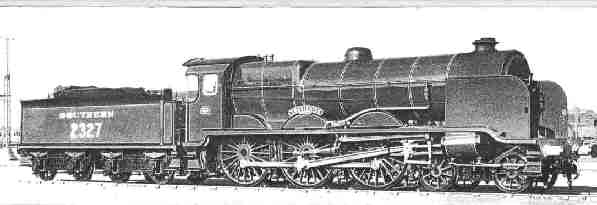
 An Interesting
Transformation
An Interesting
Transformation
The Rebuilt Baltics Tanks of the
LBSCR
A Reprint of an Article in The Coupling of April 2000 by Mike Watts

Although the LB&SCR was well supplied by modern motive power in the final years before
the First World War, the new Locomotive Superintendent, L.B.Billington decided to provide 5
new express locomotives to supplement the existing 11 Atlantics and 2 Pacific tanks. As the
Brighton was a comparatively short line, large tank locomotives were considered very suitable
for the operating conditions, providing there was enough water capacity. He set about enlarging
the design of the Pacific tanks by replacing the trailing truck by a bogie, giving both more water
and coal carrying capacity.
By the end of March 1914, no. 327 Charles C. Macrae was ready for trials. The test
runs proved successful so work was started on a second locomotive, no. 328, to the same design.
However in the meantime, no. 327 had suffered several derailments due to instability caused
by water surging and a high centre of gravity and both nos. 327 and 328 were stored from
November 1914 until May 1915, while their fate was to be decided. One option was to convert
them both to 4-6-0 tender locomotives and although this option was discarded at the time,
interestingly, 20 years later it actually came about. However, in the meantime, the decision was
made to retain them as 4-6-4 tanks with several modifications, including the provision of well
tanks and springing changes.
So no. 327 Charles C. Macrae left the main Brighton shops for a second time in
August 1915. This time it was used for several weeks on empty stock services and van trains, to
ensure that the previous troubles had been overcome. They had, and no. 327 went into front-line
service on the Brighton expresses in September. By the following March, no. 328 had been
similarly dealt with. Nos. 327 and 328 were considered by many to be the finest-looking Baltic
tanks to run in Britain.
Although originally it had been intended to build 5 Baltic tanks, the prolonged teething
troubles and the ongoing World War I caused the order for the remaining three to be cancelled at
the end of 1915.
Upon the Armistice being signed in November 1918 an immediate order for 5 more was put
in hand at Brighton Works. No 328 had never carried a name, but the first of the new five tanks,
no. 329 was named Stephenson. Very fittingly the last of the seven, no. 333 was named
Remembrance to commemorate LB&SCR employees who died during the war.
In 1931, with the coming electrification of the Brighton mainline, other uses on the Brighton
section of the new Southern Railway were considered for the seven locomotives, but generally
they were too heavy for the secondary lines. Not only that, but by then the new Southern CME,
Maunsell, had built his King Arthur class of 4-6-0s, based on the LSWR Urie N15. Several of his
King Arthurs had been drafted to front-line duty on the Brighton, including the prestigious
'Southern Belle'.
Generally, the Brighton Baltics were in fine order, with the frames, boilers and motion good
for a number of years yet. So Maunsell took them into Eastleigh Works, starting in July 1934.
Each one emerged transformed.
Gone were the long side tanks, the trailing bogie, the large bunker with its well tank and the
Brighton cab. Maunsell added smoke deflectors, and King Arthur chimney, and a Lord Nelson
cab. Behind each locomotive was a used Urie-style 8-wheel tender, taken from a Urie S15, in
one of the regular tender swaps that the Southern so loved. To add a nice touch, they became the
'Remembrance' class, although officially known as N15X.
Nos. 329 and 333 retained their names, but our pictured locomotive, no 327, received the
name of historic locomotive engineer, Trevithick. The remaining four were named
Hackworth, Cudworth, Beattie and Stroudley.
The Remembrance rebuilds were all sent to the ex-LSWR lines of the Southern.
Although nominally of the same power as the King Arthurs, in reality, they were not a
match for the heaviest of duties and remained on secondary duties. Although a good King
Arthur could substitute for a Lord Nelson at any time, this was not so for an N15X.
During the Second World War, when Swindon was short of motive power all the ex-
Brighton 4-6-0s were lent to the GWR and no. 2327 Trevithick was on regular turns
working out of Old Oak Common from January to July 1943. After the war, the appearance of
140 Bulleid pacifics pretty well doomed these 7 strange left overs from WWI, and by 1957 all
had been scrapped. Our favourite, now no. 32327 Trevithick, was withdrawn in January
1956 and none of these handsome ex-Baltic tanks survived the scrapper's torch.
© Mike Watts 2000

April 2001